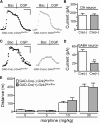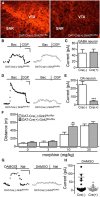GIRK Channels Modulate Opioid-Induced Motor Activity in a Cell Type- and Subunit-Dependent Manner
- PMID: 25948263
- PMCID: PMC4420781
- DOI: 10.1523/JNEUROSCI.5051-14.2015
GIRK Channels Modulate Opioid-Induced Motor Activity in a Cell Type- and Subunit-Dependent Manner
Abstract
G-protein-gated inwardly rectifying K(+) (GIRK/Kir3) channel activation underlies key physiological effects of opioids, including analgesia and dependence. GIRK channel activation has also been implicated in the opioid-induced inhibition of midbrain GABA neurons and consequent disinhibition of dopamine (DA) neurons in the ventral tegmental area (VTA). Drug-induced disinhibition of VTA DA neurons has been linked to reward-related behaviors and underlies opioid-induced motor activation. Here, we demonstrate that mouse VTA GABA neurons express a GIRK channel formed by GIRK1 and GIRK2 subunits. Nevertheless, neither constitutive genetic ablation of Girk1 or Girk2, nor the selective ablation of GIRK channels in GABA neurons, diminished morphine-induced motor activity in mice. Moreover, direct activation of GIRK channels in midbrain GABA neurons did not enhance motor activity. In contrast, genetic manipulations that selectively enhanced or suppressed GIRK channel function in midbrain DA neurons correlated with decreased and increased sensitivity, respectively, to the motor-stimulatory effect of systemic morphine. Collectively, these data support the contention that the unique GIRK channel subtype in VTA DA neurons, the GIRK2/GIRK3 heteromer, regulates the sensitivity of the mouse mesolimbic DA system to drugs with addictive potential.
Keywords: GIRK; Kir3; conditional knockout; morphine; rostromedial tegmental area; ventral tegmental area.
Copyright © 2015 the authors 0270-6474/15/357131-12$15.00/0.
Figures








Similar articles
-
GIRK Channel Activity in Dopamine Neurons of the Ventral Tegmental Area Bidirectionally Regulates Behavioral Sensitivity to Cocaine.J Neurosci. 2019 May 8;39(19):3600-3610. doi: 10.1523/JNEUROSCI.3101-18.2019. Epub 2019 Mar 5. J Neurosci. 2019. PMID: 30837265 Free PMC article.
-
Selective Ablation of GIRK Channels in Dopamine Neurons Alters Behavioral Effects of Cocaine in Mice.Neuropsychopharmacology. 2017 Feb;42(3):707-715. doi: 10.1038/npp.2016.138. Epub 2016 Jul 29. Neuropsychopharmacology. 2017. PMID: 27468917 Free PMC article.
-
A Role for the GIRK3 Subunit in Methamphetamine-Induced Attenuation of GABAB Receptor-Activated GIRK Currents in VTA Dopamine Neurons.J Neurosci. 2016 Mar 16;36(11):3106-14. doi: 10.1523/JNEUROSCI.1327-15.2016. J Neurosci. 2016. PMID: 26985023 Free PMC article.
-
G Protein-Gated Potassium Channels: A Link to Drug Addiction.Trends Pharmacol Sci. 2017 Apr;38(4):378-392. doi: 10.1016/j.tips.2017.01.007. Epub 2017 Feb 7. Trends Pharmacol Sci. 2017. PMID: 28188005 Free PMC article. Review.
-
Molecular mechanisms of analgesia induced by opioids and ethanol: is the GIRK channel one of the keys?Neurosci Res. 2002 Oct;44(2):121-131. doi: 10.1016/s0168-0102(02)00094-9. Neurosci Res. 2002. PMID: 12354627 Review.
Cited by
-
GIRK3 deletion facilitates kappa opioid signaling in chondrocytes, delays vascularization and promotes bone lengthening in mice.Bone. 2022 Jun;159:116391. doi: 10.1016/j.bone.2022.116391. Epub 2022 Mar 18. Bone. 2022. PMID: 35314385 Free PMC article.
-
Chronic ethanol exposure in mice evokes pre- and postsynaptic deficits in GABAergic transmission in ventral tegmental area GABA neurons.Br J Pharmacol. 2025 Jan;182(1):69-86. doi: 10.1111/bph.17335. Epub 2024 Oct 2. Br J Pharmacol. 2025. PMID: 39358985 Free PMC article.
-
Suppression of pyramidal neuron G protein-gated inwardly rectifying K+ channel signaling impairs prelimbic cortical function and underlies stress-induced deficits in cognitive flexibility in male, but not female, mice.Neuropsychopharmacology. 2021 Nov;46(12):2158-2169. doi: 10.1038/s41386-021-01063-w. Epub 2021 Jun 23. Neuropsychopharmacology. 2021. PMID: 34158613 Free PMC article.
-
Using the shared genetics of dystonia and ataxia to unravel their pathogenesis.Neurosci Biobehav Rev. 2017 Apr;75:22-39. doi: 10.1016/j.neubiorev.2017.01.033. Epub 2017 Jan 28. Neurosci Biobehav Rev. 2017. PMID: 28143763 Free PMC article. Review.
-
Direct activation of G-protein-gated inward rectifying K+ channels promotes nonrapid eye movement sleep.Sleep. 2019 Mar 1;42(3):zsy244. doi: 10.1093/sleep/zsy244. Sleep. 2019. PMID: 30535004 Free PMC article.
References
-
- Arora D, Hearing M, Haluk DM, Mirkovic K, Fajardo-Serrano A, Wessendorf MW, Watanabe M, Luján R, Wickman K. Acute cocaine exposure weakens GABA(B) receptor-dependent G-protein-gated inwardly rectifying K+ signaling in dopamine neurons of the ventral tegmental area. J Neurosci. 2011;31:12251–12257. doi: 10.1523/JNEUROSCI.0494-11.2011. - DOI - PMC - PubMed
Publication types
MeSH terms
Substances
Grants and funding
- R21 DA029343/DA/NIDA NIH HHS/United States
- DA011806/DA/NIDA NIH HHS/United States
- MH061933/MH/NIMH NIH HHS/United States
- T32 DA007097/DA/NIDA NIH HHS/United States
- R01 DA037170/DA/NIDA NIH HHS/United States
- DA007097/DA/NIDA NIH HHS/United States
- T32 DA007234/DA/NIDA NIH HHS/United States
- DA029343/DA/NIDA NIH HHS/United States
- R01 DA034696/DA/NIDA NIH HHS/United States
- P50 DA011806/DA/NIDA NIH HHS/United States
- R01 MH061933/MH/NIMH NIH HHS/United States
- DA007234/DA/NIDA NIH HHS/United States
- P30 CA068485/CA/NCI NIH HHS/United States
- T32 GM008471/GM/NIGMS NIH HHS/United States
- GM008471/GM/NIGMS NIH HHS/United States
- DA07234/DA/NIDA NIH HHS/United States
- CA068485/CA/NCI NIH HHS/United States
- R01 AA018734/AA/NIAAA NIH HHS/United States
- DA034696/DA/NIDA NIH HHS/United States
LinkOut - more resources
Full Text Sources
Molecular Biology Databases
